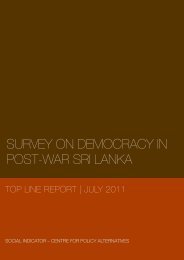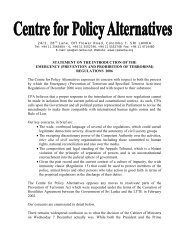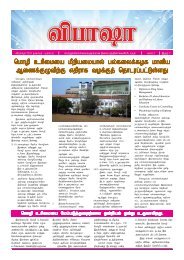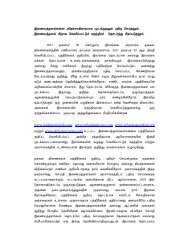States of Emergency - Centre for Policy Alternatives
States of Emergency - Centre for Policy Alternatives
States of Emergency - Centre for Policy Alternatives
You also want an ePaper? Increase the reach of your titles
YUMPU automatically turns print PDFs into web optimized ePapers that Google loves.
neither deLines a state <strong>of</strong> emergency, nor enumerates the<br />
conditions under which a declaration becomes legally available. 84<br />
This is the approach <strong>of</strong> the Sri Lankan constitution as well.<br />
Chapter XVIII <strong>of</strong> the constitution is entirely a procedural<br />
framework, which imposes no objective conditionalities on the<br />
presidential discretion in respect <strong>of</strong> a declaration <strong>of</strong> a state <strong>of</strong><br />
emergency. However, these constitutional provisions are premised<br />
on the statutory elaboration <strong>of</strong>, inter alia, the presidential<br />
discretion with regard to a declaration. Accordingly, the Public<br />
Security Ordinance No. 25 <strong>of</strong> 1947 as amended (PSO) provides<br />
that such a declaration may be made where, in the opinion <strong>of</strong> the<br />
President, there exists or imminently exists a state <strong>of</strong> public<br />
emergency which requires emergency powers to be used ‘in the<br />
interests <strong>of</strong> public security and the preservation <strong>of</strong> public order, or<br />
<strong>for</strong> the maintenance <strong>of</strong> supplies and services essential to the life <strong>of</strong><br />
the community.’ 85<br />
Other constitutions resolve the deLinitional problem by providing<br />
<strong>for</strong> a several types <strong>of</strong> emergency regime. Broadly, these fall into<br />
two categories: those that provide <strong>for</strong> a dual structure <strong>of</strong><br />
emergency regime, and those that envisage a multiple structure.<br />
Many <strong>of</strong> the post‐communist Eastern European constitutions<br />
provide a dual structure <strong>of</strong> emergency regime, 86 as do the<br />
constitutions <strong>of</strong> the Netherlands and Portugal. The Dutch<br />
constitution differentiates between a ‘state <strong>of</strong> war’ and a ‘state <strong>of</strong><br />
84<br />
Articles 38, 39, Basic Law: The Government, 1780 SH (2001); see also<br />
Baruch Bracha (2003) ‘Checks and Balances in a Protracted State <strong>of</strong> <br />
<strong>Emergency</strong> – The Case <strong>of</strong> Israel’ 33 Israel Yearbook on Human Rights 123<br />
85<br />
Section 2 (1) <strong>of</strong> the PSO<br />
86<br />
See Venelin I. Ganev (1997) ‘<strong>Emergency</strong> Powers and the New East <br />
European Constitutions’ 45 American Journal <strong>of</strong> Comparative Law 585<br />
69











